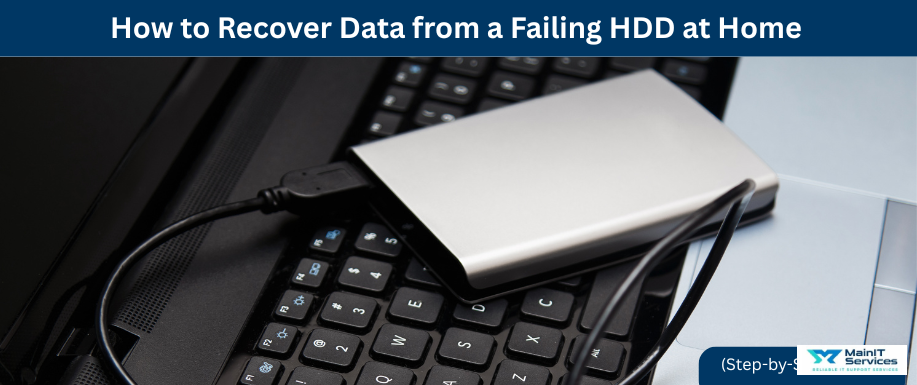
If your hard drive is acting up, freezing, clicking, or just refusing to open files, don’t panic. It’s possible to recover data from a failing HDD right from the comfort of your home, provided the damage isn’t too far gone.
Many people lose valuable files simply because they don’t know how or when to act.
In this guide, you’ll learn safe, effective methods to retrieve important data before it disappears for good.
Recognize the Signs of Drive Failure to Recover Data from a Failing HDD
Do not go ahead with recovery at this point unless you are positive that you are dealing with a failing HDD. Some of the symptoms include:
-
System crashes or freezes regularly
-
Clicking, grinding, or beeping noises
-
Files or folders are missing
-
The system is unable to detect the drive at all
If your drive is emitting mechanical noises, that indicates a hardware failure and should be addressed by professionals.
However, if the harm is minor, such as corrupted files or partition issues, you can attempt to recover it at home.
Precautions Before You Begin
1. Don't Use the Drive Right Away
The more you use a dying drive, the greater the risk of overwriting or destroying existing data. Unplug it, especially if it's making noises.
2. Plug It into a Secondary Computer
Use a SATA-to-USB enclosure or cable to connect the hard drive to a second, healthy computer. Don't boot off the dying drive itself.
3. Make a Clone (Optional but Highly Recommended)
To safeguard what's remaining, make a clone of the drive with software such as Macrium Reflect or Clonezilla. Make changes off the clone to prevent further strain on the dying drive.
Did You Know? Losing important files, such as thousands of photos or videos, from an SD card can be devastating. However, all hope is not lost. You can recover your lost files from an SD card on your Mac with the right steps, tools, and techniques.
Tools You'll Need to Retrieve Data from a Dying HDD
Recovering data from a dying HDD is a breeze with the right tools. The following are the tools you'll require:
Hardware:
-
SATA to USB adapter
-
External backup drive
Functional PC
-
Software (Pick One):
-
Recuva – Friendly and free for minor recoveries
PhotoRec/TestDisk – Powerful open-source tools
EaseUS Data Recovery Wizard – Great deep scans (paid)
Disk Drill – Decent UI and acceptable free recovery limits
Recover Data From Failing HDD| Process Step by Step
Step 1: Plug in the Drive
Plug your dying drive into a good computer using the adapter. Check if it appears in Disk Management.
Step 2: Select Recovery Software
Download any of the programs above and install them. Open it and select your drive, and start a deep scan for lost files.
Step 3: Recover and Save
Once the scanning process is complete, choose the files you need. Recovered files are saved to another drive, not the faulty one.
Step 4: Organize and Backup
Duplicate important data to cloud storage or a fresh external HDD to avoid future failures.
You can also watch if you need more assistance: How to Recover Data from Old Hard Drives?
When to Call a Professional?
If your drive is:
-
Not showing up in BIOS
-
Grinding or clicking noises
-
Overheating or a burning smell
Then leave it. Don't attempt DIY repair. You can cause permanent harm. Cleanroom and high-end equipment in professional recovery facilities recover data safely.
Need expert help? Main IT Solutions provides professional, trustworthy data recovery services that avoid permanent data loss.
Myths to Avoid
Freezing the hard drive: This is an older technique and will not succeed. It will damage the platter.
-
Running random "fix" utilities: Some of them can overwrite data or exacerbate the damage.
-
Formatting: This erases directory information and makes complete recovery more problematic.
-
Non-destructive tools should always be given the highest priority and attempted whenever possible on cloned images.
How to Avoid This in the Future?
Having recovered data from a dying HDD, here's how to remain safe in the future:
-
Backup data regularly to both cloud and physical storage
-
Check your drive's health using SMART tools such as CrystalDiskInfo
-
Prevent overheating and mechanical shock to your drives
-
Swap out old hard drives before they crash
Conclusion
Not every hard drive can be saved, but logical errors and bad sectors can typically be recovered with the procedures above. Working quickly and with the proper tools gives the best chance of success.
And keep in mind, if it seems too risky, don't risk it with your data.
Professional data recovery or IT service? Contact Main IT Services, your trusted partner in the recovery of what matters most.
Need expert help?
If these measures seem overwhelming, or your information is too valuable to risk, contact Main IT Solutions for speedy, reliable data recovery services.

.png)

